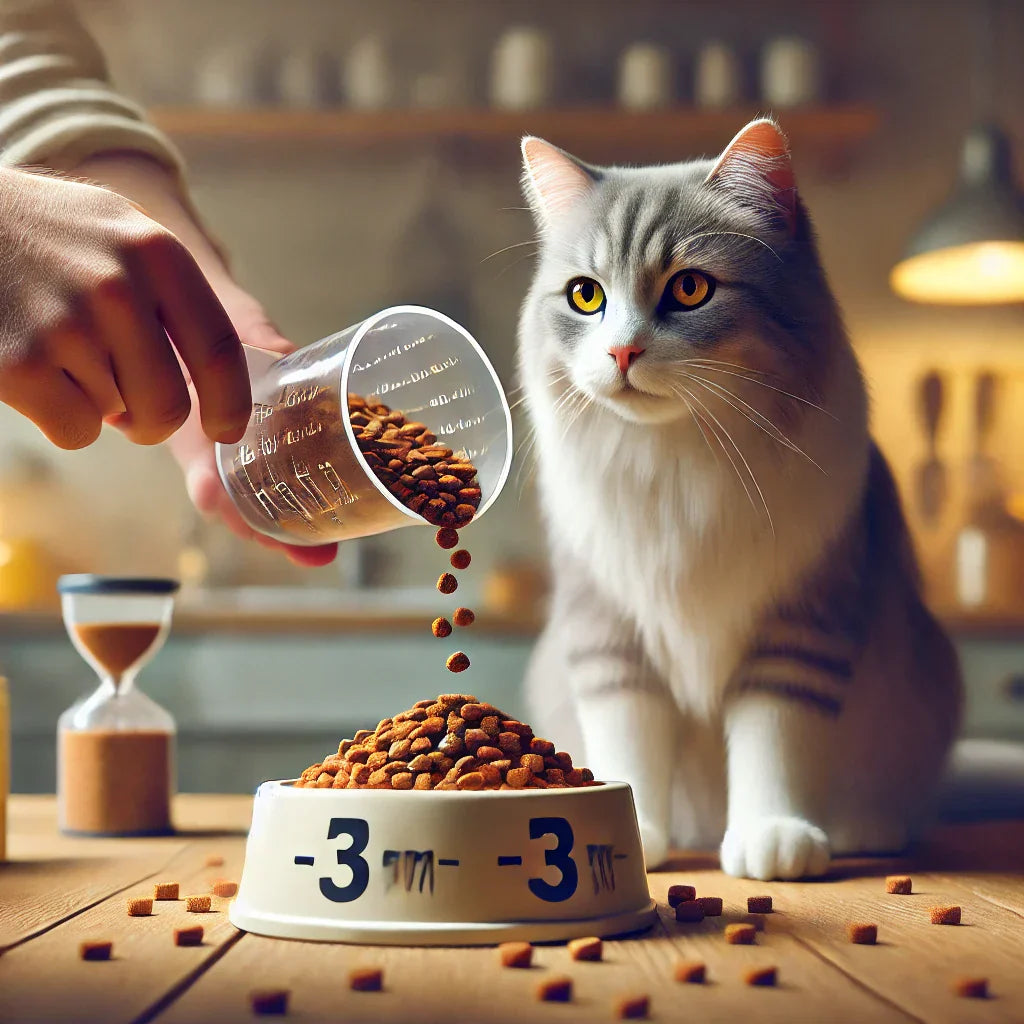
How Much Should You Feed Your Cat? A Comprehensive Guide
Share
Feeding your feline friend the right amount of food is a cornerstone of their health and well-being. It’s a seemingly simple task, yet it's fraught with nuances that can leave even the most dedicated cat parents scratching their heads. Overfeeding can lead to obesity, a prevalent issue in domestic cats that brings with it a host of health problems like diabetes, arthritis, and heart disease. Conversely, underfeeding can result in malnutrition, stunted growth (especially in kittens), and a weakened immune system. So, how do you navigate this nutritional tightrope and ensure your cat is getting precisely what they need? This comprehensive guide will delve into the various factors that influence a cat's dietary requirements, providing you with the knowledge to make informed decisions about your furry companion's meals.

Are You Feeding Your Cat the Right Amount? Here’s How to Know
The first and perhaps most crucial step in determining how much to feed your cat is understanding that there's no one-size-fits-all answer. Just like humans, cats have individual needs that vary based on a multitude of factors. Age is a significant determinant. Kittens, with their rapid growth spurts and boundless energy, require more calories and nutrients per pound of body weight than adult cats. Their bodies are building bones, muscles, and organ systems at an astonishing rate, necessitating a diet rich in protein, fats, and essential vitamins and minerals. Adult cats, having reached their full size, require a diet to maintain their weight and support their daily activities. Senior cats, typically those over seven years old, often have slower metabolisms and may be less active, requiring fewer calories. However, some senior cats may also have underlying health conditions that necessitate a specialized diet or increased caloric intake to maintain weight.
Activity level is another key factor. An indoor cat who spends most of their day napping will have different caloric needs than an outdoor cat who spends hours hunting and exploring. The more active a cat is, the more energy they expend, and consequently, the more calories they require to fuel their adventures. Indoor cats are often at a higher risk of obesity due to their sedentary lifestyles, making careful portion control even more critical. Outdoor cats, on the other hand, might need extra calories to compensate for the energy burned while roaming and to maintain their body temperature, especially in colder climates.
Weight and body condition score are also vital considerations. Ideally, you should be feeding your cat to maintain a healthy weight. This isn't just about a number on a scale; it's about their overall body composition. A veterinarian can help you determine your cat's ideal weight based on their breed and size. However, you can also assess your cat's body condition at home. A cat at a healthy weight should have a palpable but not visible ribcage, a noticeable waist when viewed from above, and an abdominal tuck when viewed from the side. If you can easily see your cat's ribs, they are likely underweight. If you can't feel their ribs at all, or if they have a rounded abdomen and no visible waist, they are likely overweight. Adjusting their food intake based on their body condition score is crucial for preventing weight-related health issues.
Reproductive status also plays a role in a cat's nutritional needs. Pregnant and nursing cats have significantly increased caloric requirements to support the growth of their kittens and milk production. These cats often need to eat several small meals throughout the day and may even benefit from free-feeding to ensure they are getting enough calories. Once the kittens are weaned, the mother cat's food intake should gradually return to normal. Spayed or neutered cats, on the other hand, often have lower metabolic rates and may require fewer calories to maintain a healthy weight. This is why it's essential to adjust their food intake after they have been spayed or neutered to prevent weight gain.
Beyond these fundamental factors, individual variations can also influence how much a cat should eat. Some breeds are naturally larger or more muscular and may require more food than smaller, more delicate breeds. A cat's metabolism can also vary, with some cats burning calories more efficiently than others. Underlying health conditions can also significantly impact a cat's dietary needs. Cats with kidney disease, diabetes, hyperthyroidism, or inflammatory bowel disease, for example, may require specialized diets with specific nutrient profiles and caloric adjustments. It's crucial to consult with your veterinarian if your cat has any health issues to determine the most appropriate feeding plan.
Once you have a better understanding of the factors influencing your cat's individual needs, the next step is to determine the actual amount of food they should be eating. One common method is to use the feeding guidelines provided on the cat food packaging. These guidelines are usually based on the cat's weight and are a good starting point. However, it's important to remember that these are just general recommendations and may need to be adjusted based on your cat's specific circumstances. For example, a very active cat might need more food than the guidelines suggest for their weight, while a sedentary cat might need less.

Another approach is to calculate your cat's daily caloric needs. This method is more precise but requires a bit of math. The resting energy requirement (RER) is the baseline number of calories a cat needs at rest. It can be calculated using the following formula: RER = 70 x (body weight in kilograms)^0.75. Once you have the RER, you can multiply it by an activity factor to get the daily energy requirement (DER). The activity factor varies depending on the cat's lifestyle:
- Sedentary adult cat: RER x 1.2
- Moderately active adult cat: RER x 1.4
- Active adult cat: RER x 1.6
- Kittens up to 4 months: RER x 2.5
- Kittens 4 months to 1 year: RER x 2.0
- Pregnant or nursing cats: RER x 2.0 to 6.0 (depending on the stage of pregnancy or lactation)
- Weight loss: RER x 0.8
- Weight gain: RER x 1.2 to 1.8
It's important to note that these are just estimates, and individual needs can vary. Consulting with your veterinarian is always recommended to determine the most accurate caloric needs for your cat. Once you know your cat's daily caloric requirement, you can then determine how much of their food provides that many calories by looking at the calorie content listed on the food packaging.
Choosing the right type of food is also an important part of the equation. There are two main types of cat food: dry kibble and wet food. Dry food is convenient and can be left out for cats to graze on throughout the day. It also helps to keep their teeth clean. However, dry food is typically higher in carbohydrates and lower in moisture content, which can be a concern for some cats, especially those prone to urinary issues or dehydration. Wet food, on the other hand, has a high moisture content, which can help with hydration and is often more palatable for cats. It's also typically lower in carbohydrates and higher in protein. Some cat owners choose to feed their cats a combination of both wet and dry food, which can offer the benefits of both types.
Regardless of whether you choose dry or wet food, it's crucial to select a high-quality food that is specifically formulated for cats and meets their nutritional needs. Look for foods that are labeled as "complete and balanced" by the Association of American Feed Control Officials (AAFCO). This ensures that the food contains all the essential nutrients your cat needs in the correct proportions. Pay attention to the ingredient list, and choose foods that have a named protein source (like chicken, fish, or beef) listed as one of the top ingredients. Avoid foods that are primarily made up of fillers like corn or wheat.

Once you've determined how much to feed your cat and what type of food to feed them, the next consideration is how often to feed them. Cats are natural grazers and often prefer to eat multiple small meals throughout the day. In the wild, they would eat several small prey animals. Mimicking this natural feeding pattern can be beneficial for indoor cats as well. Instead of feeding one or two large meals a day, consider dividing their daily food allowance into three or four smaller meals. This can help to keep them satisfied, prevent overeating, and maintain stable blood sugar levels.
However, for some cats, especially those who tend to overeat, scheduled meals may be more appropriate. This allows you to control their portion sizes and prevent them from consuming too many calories. If you opt for scheduled meals, consistency is key. Try to feed your cat at the same times each day, as this can help to establish a routine and reduce begging.
Free-feeding, where food is available at all times, is another option, but it's generally not recommended for adult cats due to the risk of obesity. It might be suitable for very active cats or those who struggle to maintain weight, but it requires careful monitoring of their food intake and body condition. Free-feeding is more commonly used for kittens, who need constant access to food to support their rapid growth.
Regardless of the feeding method you choose, it's essential to monitor your cat's weight and body condition regularly and adjust their food intake as needed. If your cat is gaining weight, you may need to reduce their portion sizes or switch to a lower-calorie food. If they are losing weight, you may need to increase their portion sizes or switch to a higher-calorie food. Regular check-ups with your veterinarian are also crucial for monitoring your cat's overall health and ensuring their diet is meeting their needs.
Treats can be a part of a healthy cat's diet, but they should be given in moderation. Treats should not make up more than 10% of your cat's daily calorie intake. When giving treats, make sure to factor those calories into their overall daily allowance to avoid overfeeding. Choose healthy treats that are low in calories and made with quality ingredients.
Making changes to your cat's diet should be done gradually to avoid digestive upset. If you're switching to a new food, start by mixing a small amount of the new food with their old food, and gradually increase the amount of the new food over a period of 7-10 days while decreasing the amount of the old food.

Finally, remember that fresh, clean water should always be available to your cat. Water is essential for their overall health and well-being. Ensure their water bowl is cleaned and refilled daily.
Determining how much to feed your cat is an ongoing process that requires careful observation and adjustments as their needs change throughout their life. By understanding the factors that influence their dietary requirements, choosing a high-quality food, and monitoring their weight and body condition, you can help your feline friend maintain a healthy weight and enjoy a long and happy life. When in doubt, always consult with your veterinarian, who can provide personalized recommendations based on your cat's individual needs and health status.
Cat Blogs: Cat Behavior | Cat Food | Cat Health & Care | Cat Training | Cat Breeds | Cat Lifestyle | Cat People
Visit our blogs page for more fun cat topics and cat products visit www.catcurio.com
Follow CatCurio: Instagram I Facebook I Twitter I YouTube I Tumblr I Pinterest
